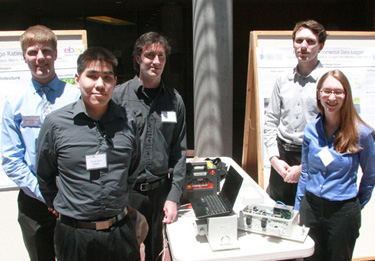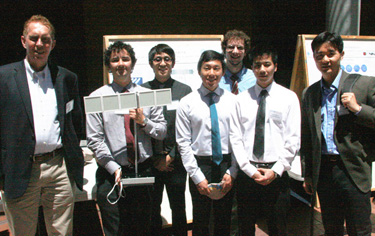A dozen teams of students in the Baskin School of Engineering at UC Santa Cruz spent their senior year working on real-world engineering projects given to them by technology companies. The resulting prototypes include a mobile climate lab that measures air pollution and other environmental data and displays it on Google Maps; an organic LED desk lamp that uses an order of magnitude less energy than a conventional lamp; a Netflix movie recommendation app for smart phones; an app using gamification and crowd-sourcing to help eBay sellers provide good photos of their products; and a high-speed face detection system for images and live video.
"This is new technology created by undergraduates," said Art Ramirez, dean of the Baskin School of Engineering. "It's great experience for the students, and it gives the corporate sponsors an opportunity to see what our students are capable of."
The engineering school's Corporate Sponsored Senior Project Program, now in its second year, held a Senior Design Partners Day on Thursday, May 30, featuring student presentations and demonstrations.
Pat Mantey, associate dean for industry programs and director of the program, said he enjoys watching a group of students develop as a team and learn to work together effectively. "When they have 20 weeks to work on a focused project, that's when everything really gels for them. They learn to work as an engineer in the real world--how to plan, manage a budget, and work in teams in a diverse environment," Mantey said.
The corporate sponsors this year include Altera, Applied Materials, CITRIS, Dell KACE, eBay, Echelon, Google, Netflix, Oracle, Raytheon Applied Signal Technology, Xilinx, and Yaskawa. Mentors from each company provided guidance and technical support for the student teams.
William McGrath, a student on the Applied Materials team, said the OLED desk lamp project was very challenging, but well worth the hard work and long hours that went into it. "I feel much more prepared now to go into an engineering job," he said.
"Working on a project like this is a great experience because you learn a lot of practical things that you don't learn in classes," said Carol Owens, a member of the Google mobile climate lab team.
Teaching fellow David Munday, who worked closely with many of the student teams, emphasized the importance of system-level integration and design. "In today's increasingly networked world, you need to think about how your product can be integrated with other technologies," he said.
At Thursday's event, Munday gave a demonstration of how four student teams were able to integrate their projects. The demonstration began with an accelerated face detection system developed by the Altera team and running on a PC. When the system detected Munday's face (through a standard web cam), it greeted him in a computerized voice and told him that it was launching the Google climate lab website (which appeared on the screen) and turning on the Applied Materials OLED lamp (which then illuminated a desk at the front of the room). The wireless signal that turned on the lamp was sent using the Echelon team's networking platform.
"I gave them this assignment Tuesday night, and they had it working by Thursday morning," Munday said.
Linda Werner, an adjunct professor of computer science who helped students working on several software projects, said teamwork and communication are critical skills the students learned from their projects. They also learned to work within the constraints specified by their corporate sponsors, she said. "For Netflix, for example, the user experience is critical, and what the user sees is strictly prescribed, so that was an interesting thing for the students to navigate in building a mobile app," Werner said.
In addition to the corporate-sponsored projects, the presentations included three teams without corporate sponsorship: a remote-controlled quadcopter device; a robotic lifeguard to help rescue struggling swimmers; and robot for collecting extraterrestrial samples, which is an entry in the NASA Centennial Challenge competition.
"We included these projects to show that we have a lot of student talent and plenty of opportunities for additional corporate sponsorships," Mantey said.





